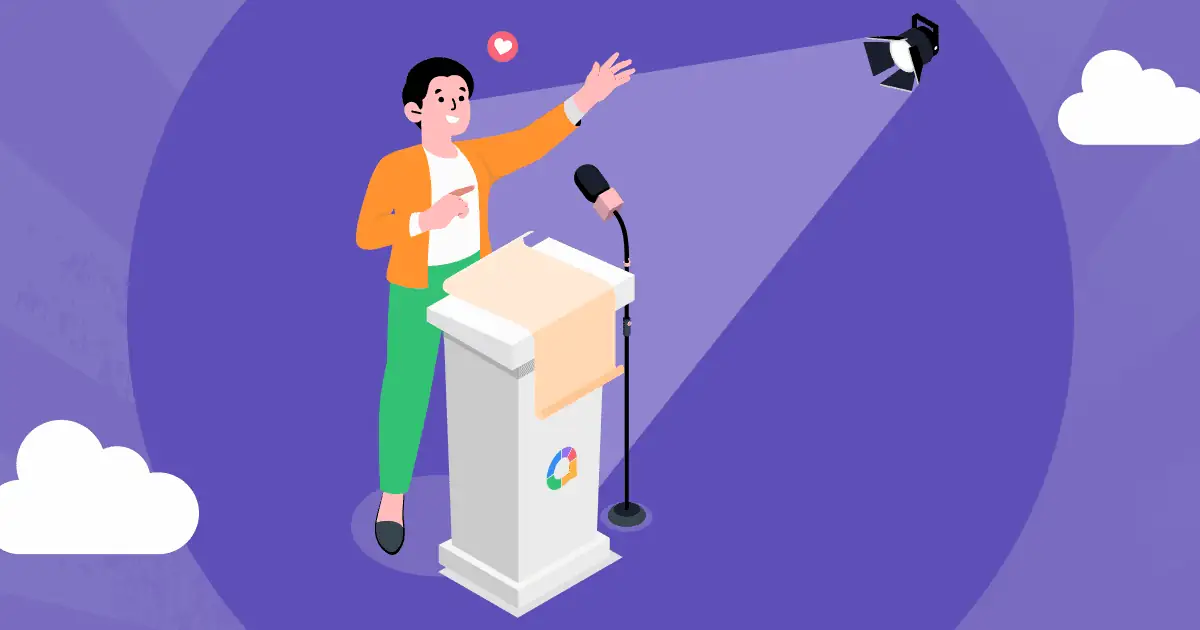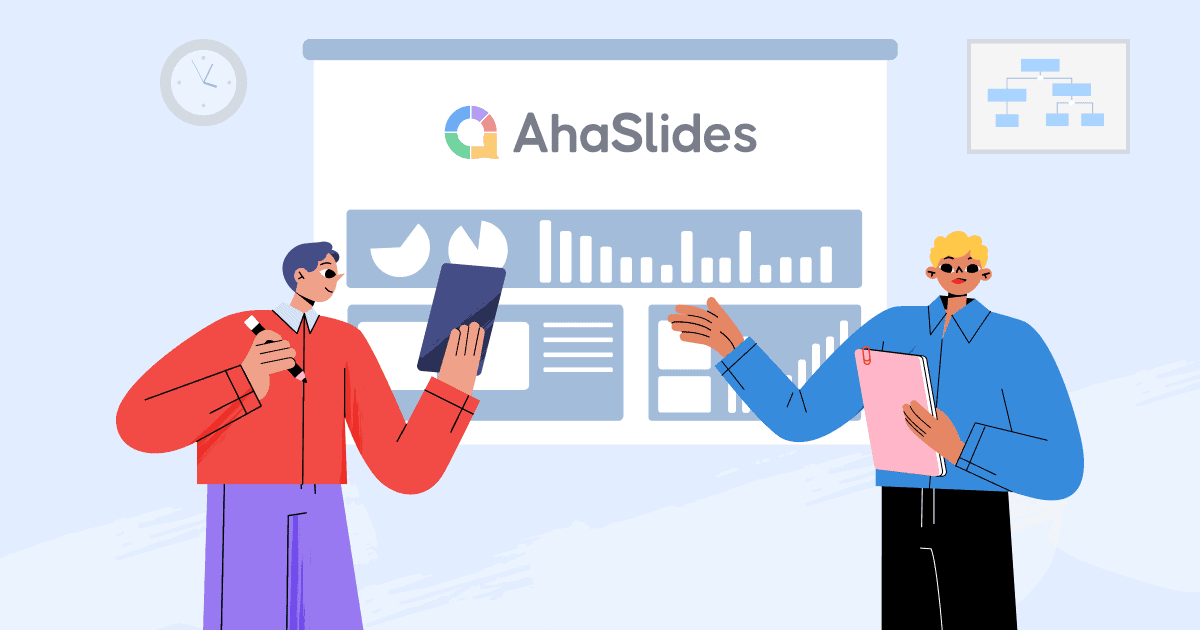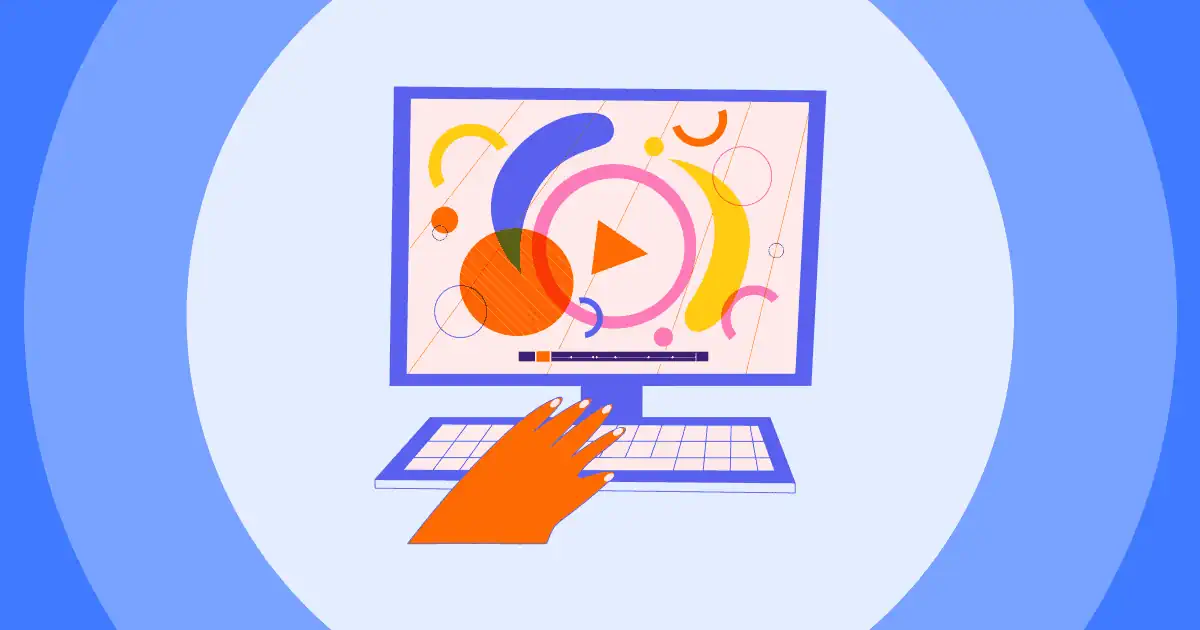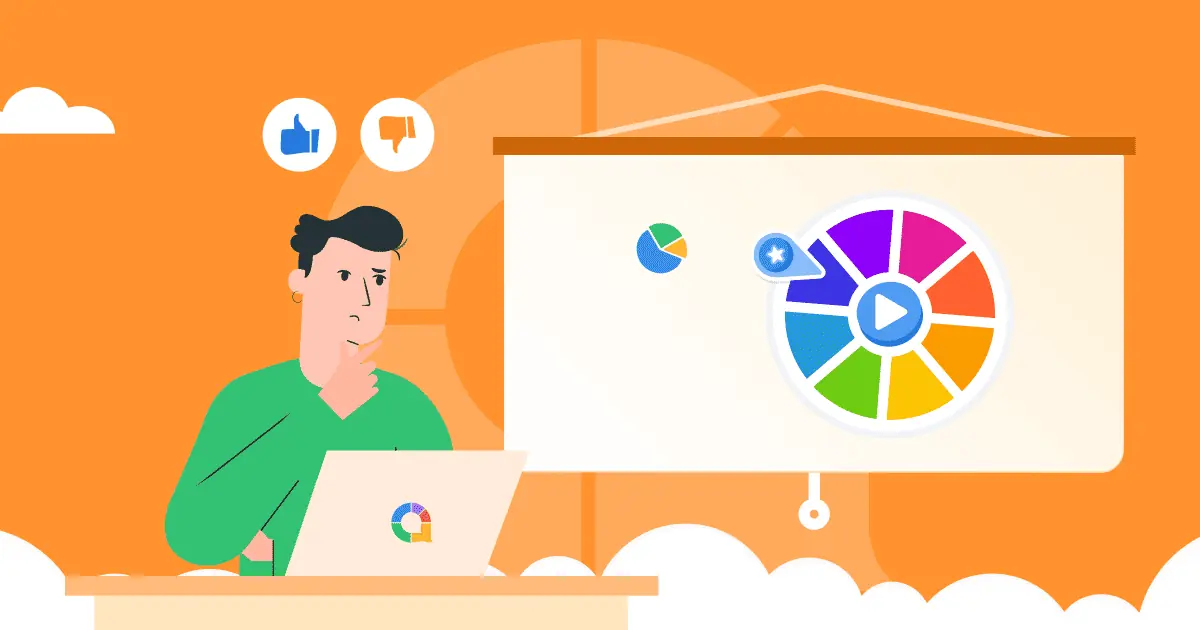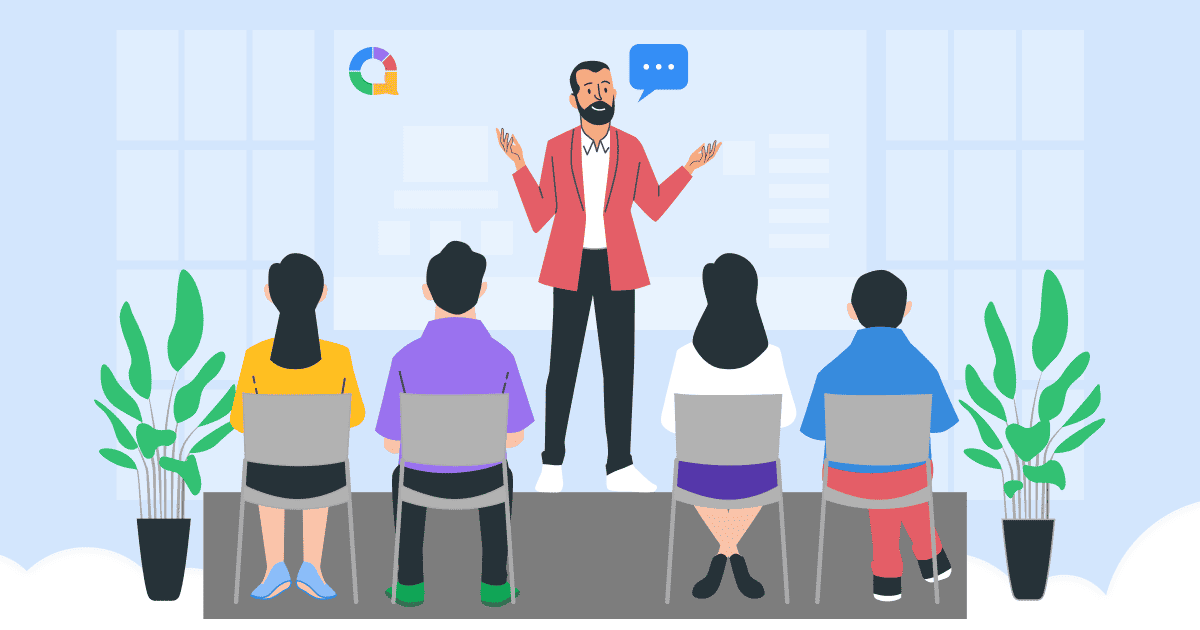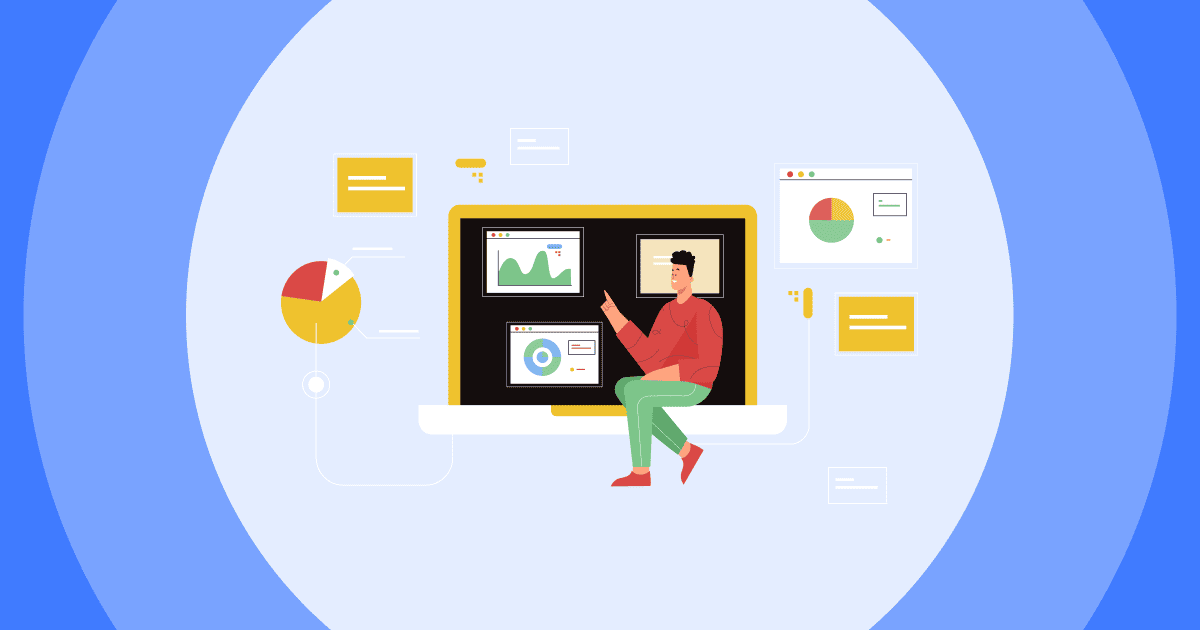Did you know this? Knowing how to start a presentation is knowing how to present.
No matter how brief, the first moments of your presentation are a huge deal. They have a massive impact not only on what follows but also on whether or not your audience follows along with you.
Sure, it's tricky, it's nerve-wracking, and it's crucial to nail down. But, with these 13 ways to start a presentation and appealing presentation starting words, you can captivate any audience from your very first sentence.
Ways to Start a Presentation
- Ask a Question
- Introduce as a Person
- Tell a Story
- Give a Fact
- Be Super Visual
- Use a Quote
- Make 'em Laugh
- Share Expectations
- Poll your Audience
- Live Polls, live Thoughts
- Two Truths and A Lie
- Flying Challenges
- Super Competitive Quiz Games
More Presentation Tips with AhaSlides
1. Ask a Question
Let me ask you this: how many times have you opened a presentation with a question?
Furthermore, have you ever wondered why an immediate question might be a great way to start a presentation?
Well, let me answer that one. Questions are interactive, and interactive presentation is what audiences bored to death of one-way monologues crave the most.
Robert Kennedy III, the international keynote speaker, lists four types of questions to use right at the beginning of your presentation:
| Types of Question | Examples |
|---|---|
| 1. Experiences | - When was the last time you...? - How often do you think about...? - What happened in your first-ever job interview? |
| 2. Accompaniments (To be shown alongside something else) | - How much do you agree with this statement? - Which image here speaks to you the most? - Why do you think so many people prefer this to this? |
| 3. Imagination | - What if you could....? - If you were...., how would you.....? - Imagine if this happened. What would you do...? |
| 4. Emotions | - How did you feel when this happened? - Would you be excited by this? - What's your biggest fear? |
While these questions might be engaging, they're not really questions, are they? You don't ask them in the hope that your audience will stand up, one-by-one, and actually answer them.
There's only one thing better than a rhetorical question like this: a question that your audience truly answers, live, right in the moment.
There's a free tool for that...
AhaSlides lets you start your presentation with a question slide, then gather actual answers and opinions from your audience (via their phones) in real-time. These questions can be word clouds, open-ended questions, rating scales, live quizzes, and so much more.
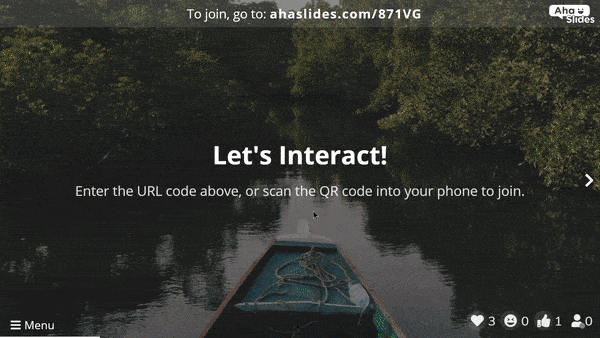
Not only does opening in this way get your audience immediately paying attention in starting a presentation, it also covers some of the other tips mentioned in this article. Including...
- Getting factual - Your audience's responses are the facts.
- Making it visual - Their responses are presented in a graph, scale or word cloud.
- Being super relatable - The audience is fully involved in your presentation, both from the outside and the inside.
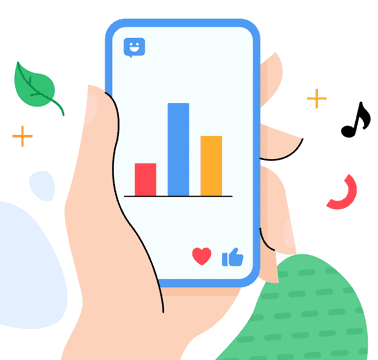
Create an Active Audience.
Click below to make a fully interactive presentation for free on AhaSlides.
2. Introduce Yourself as a Person, not a Presenter
Some great, all-encompassing advice on how to introduce yourself in a presentation comes from Conor Neill, serial entrepreneur and president of Vistage Spain.
He likens starting a presentation to meeting someone new at a bar. He's not talking about quaffing 5 pints beforehand to establish Dutch courage; more like introducing yourself in a way that feels friendly, natural and most of all, personal.
Imagine this: You're in a bar where someone piqued your interest. After a few furtive glances, you build up the courage and approach them with this:
Hi, I’m Gary, I’ve been an economic biologist for 40 years and I want to talk to you about the microeconomics of ants.
- Your introduction slide about yourself! And you're going home alone tonight.
No matter how attractive your topic is, no one wants to hear the far-too-commonly-used 'name, title, topic' procession, as it offers nothing personal to latch onto.
Imagine this: You're in the same bar a week later, and someone else has piqued your interest. Let's try this again, you think, and tonight you go with this:
Oh hey, I’m Gary, I think we know someone in common...
- You, establishing a connection.
This time, you've decided to treat your listener as a friend to be made rather than as a passive audience. You've introduced yourself in a personal way that has made a connection and has opened the door to intrigue.
When it comes to introducing ideas for the presentation, we recommend checking out the full 'How to start a presentation' speech by Conor Neill below. Sure, it’s from 2012, and he makes some dust-coated references to Blackberries, but his advice is timeless and incredibly helpful. It’s a fun watch; he’s entertaining, and he knows what he’s talking about.
3. Start by Telling a Story
If you did watch the full video above, you'd know that Conor Neill's absolute favourite tip for starting a presentation is this: telling a story.
Think about how this magical sentence makes you feel:
Once upon a time...
For pretty much every child that hears these 4 words, this is an instant attention grabber. Even as a man in his 30s, this opener still makes me wonder what might follow.
Just on the off-chance that the audience for your presentation isn't a room of 4-year-olds, don't worry - there are grown-up versions of 'once upon a time'.
And they all involve people. Just like these:
- "The other day, I met someone who completely changed my thinking..."
- "There's a person at my company who once told me...."
- "I'll never forget this customer we had 2 years ago..."
Remember this 👉 Good stories are about people; they're not about things. They're not about products or companies or revenue; they're about the lives, the achievements, the struggles and the sacrifices of the people behind the things.

Aside from conjuring an immediate surge of interest by humanising your topic, there are several other benefits to starting a presentation with a story:
- Stories make YOU more relatable - Just like in tip #2, stories can make you, the presenter, seem more personal. Your experiences with others speak far louder to audiences than stale introductions of your topic.
- They give you a central theme - Though stories are a great way to start a presentation, they also help to keep the entire thing cohesive. Calling back to your initial story at later points in your presentation not only helps to solidify your information in the real world but it also keeps the audience engaged through the narrative.
- They're jargon busters - Ever heard a children's story that starts with 'once upon a time, Prince Charming drilled down on the actionability principle inherent in agile methodology'? A good, natural story has inherent simplicity that any audience can understand.
4. Get Factual
There are more stars in the universe than there are grains of sand on earth.
Did your mind just explode with questions, thoughts and theories?
Using a fact as an opener to a presentation is an instant attention grabber.
Naturally, the more shocking the fact is, the more your audience is drawn to it. While it's tempting to go for pure shock factor, facts need to have some mutual connection with the topic of your presentation. They need to offer an easy segue into the body of your material.
Here's an example I recently used at an online event ran from Singapore 👇
"In the U.S alone, around 1 billion trees' worth of paper are thrown away yearly."
The speech I was giving was about our software, AhaSlides, which provides ways to make presentations and quizzes interactive without using stacks of paper.
Though that's not the biggest selling point of AhaSlides, it was super easy for me to connect that shocking statistic and what our software offers. From there, segueing into the bulk of the topic was a breeze.
A quote gives the audience something tangible, memorable and understandable to chew on, all while you proceed into a presentation that will likely be a series of more abstract ideas.
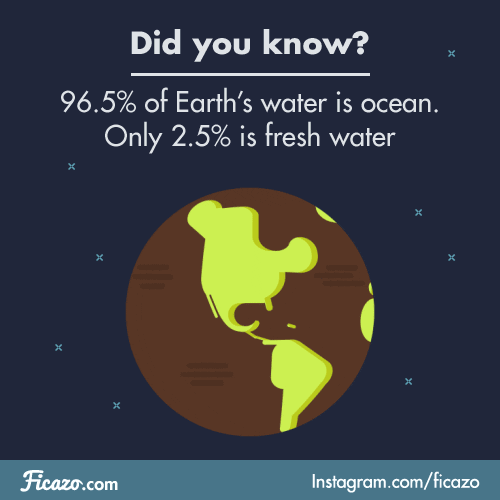
5. Make it Visual
There's a reason I chose the GIF above: it's a mix between a fact and an engaging visual.
While facts grab attention through words, visuals achieve the same thing by appealing to a different part of the brain. A more easily stimulated part of the brain.
Facts and visuals usually go hand-in-hand regarding how to start a presentation. Check out these facts about visuals:
- Using images endears you to the 65% of people who are visual learners. (Lucidpress)
- Image-based content gets 94% more views than text-based content (QuickSprout)
- Presentations with visuals are 43% more persuasive (Venngage)
It's the last stat here that has the most significant implications for you.
Think about this 👇
I could spend all day telling you, through voice and text, about the impact of plastic on our oceans. You may not listen, but the chances are that you will be more convinced by a single image:
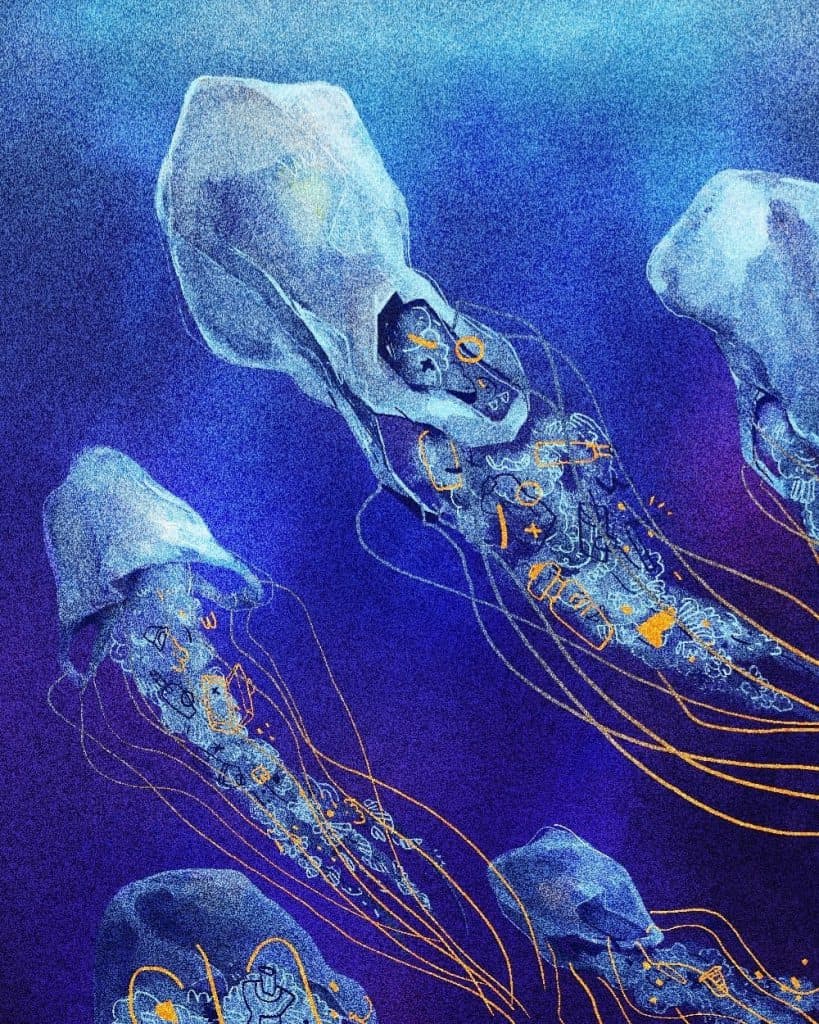
That's because images, art in particular, are way better at connecting to your emotions than I am. And connecting to emotions, whether through introductions, stories, facts, quotes or images, gives a presentation its persuasive power.
On a more practical level, visuals also help make potentially complex data super clear. While it's not a great idea to start a presentation with a graph that risks overwhelming the audience with data, visual presentation material like this can certainly be your best friend later on.
6. Use a Solitary Quote
Like a fact, a single quote might be the best way to start a presentation as it can add a vast deal of credibility to your point.
Unlike a fact, however, it's the source of the quote that often carries a lot of the gravitas.
The thing is, literally anything anyone says can be considered a quote. Stick some quotation marks around it and...
...you've got yourself a quote.
Lawrence Haywood - 2021

Starting a presentation with a quote is pretty great. What you want is a quote that starts a presentation with a bang. To do that, it has to check these boxes:
- Thought-provoking: Something that gets the audience's brains working the second they hear it.
- Punchy: Something 1 or 2 sentences long and short sentences.
- Self-explanatory: Something that requires no further input from you to aid understanding.
- Relevant: Something that helps you segue into your topic.
For mega-engagement, I've found it's sometimes a good idea to go with a controversial quote.
I'm not talking about something completely heinous that gets you thrown out of the conference, just something that doesn't encourage a unilateral 'nod and move on' response from your audience. The best opening words for presentations might come from controversial opinions.
Check this example 👇
"When I was young, I thought that money was the most important thing in life. Now that I am old, I know that it is" - Oscar Wilde.
This certainly isn't a quote that elicits total agreement. Its controversial nature offers immediate attention, a great talking point and even a way to encourage audience participation via a 'how much do you agree?' question (like in tip #1).
7. Make it Humorous
One more thing a quote can offer you is the chance to get people laughing.
How many times have you, yourself, been an unwilling audience member in your 7th presentation of the day, needing some reason to smile as the presenter plunges you head-first into the 42 problems of stopgap solution bring?
Humour takes your presentation one step closer to a show and one step further from a funeral procession.
Aside from being a great stimulator, a bit of comedy can also give you these benefits:
- To melt the tension - For you, primarily. Kicking off your presentation with a laugh or even a chuckle can do wonders for your confidence.
- To form a bond with the audience - The very nature of humour is that it's personal. It's not business. It's not data. It's human, and it's endearing.
- To make it memorable - Laughter has been proven to increase short-term memory. If you want your audience to remember your key takeaways: make 'em laugh.
Not a comedian? Not a problem. Check out these tips on how to start a presentation with humour 👇
- Use a funny quote - You don't have to be funny if you quote someone who is.
- Don't crowbar it - If you're finding it difficult to think of a funny way to start your presentation, just leave it. Forced humour is the absolute worst.
- Flip the script - I mentioned in tip #1 to keep introductions away from the over-flogged 'name, title, topic' formula, but the 'name, title, pun' formula can funnily break the mould. Check out below what I mean...
My name is (name), I am a (title) and (pun).
And here it is in action:
My name is Chris, I'm an astronomer and lately my whole career has been looking up.
You, getting off on the right foot
8. Share Expectations in Presentation Openers
People have different expectations and background knowledge when they attend your presentations. Knowing their objectives can provide a value that you can use to adjust your presenting style. Adapting to people’s needs and meeting the expectations of everyone can result in a successful presentation for all involved.
You can do this by holding a small Q&A session on AhaSlides. When you start your presentation, invite attendees to post the questions they are most curious about. You can use the Q and A slide pictured below.
Some questions that I am happy to be asked:
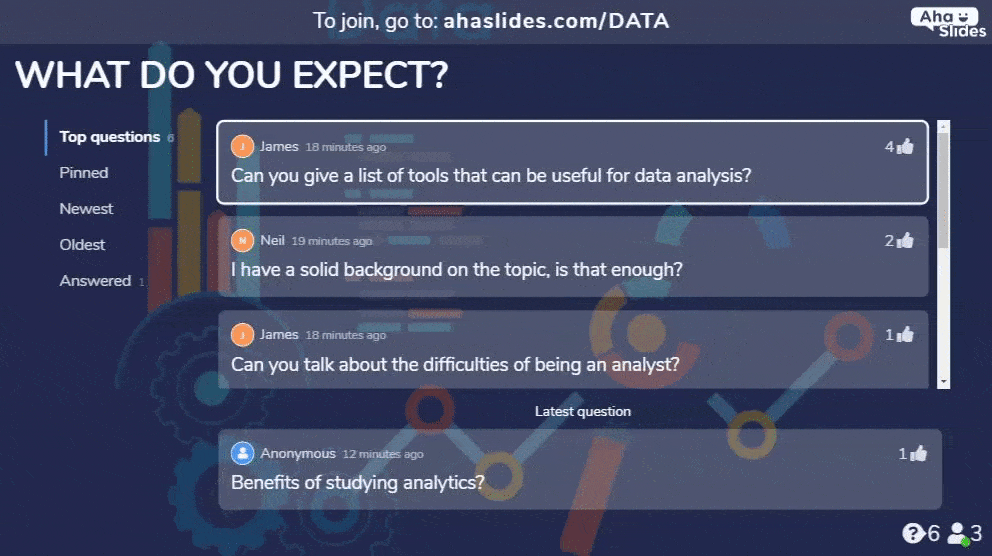
9. Poll your audience
This is another easy way to boost the excitement levels and creativity of everyone in the room! As the host, split the audience into pairs or trios, give them a topic and then ask teams to make a list of possible responses. Then have each team submit their answers as fast as possible to a Word Cloud or Open-Ended question panel on AhaSlides. The results will show up live in your slide show!
The topic of the game does not need to be the topic of the presentation. It can be about anything fun but provokes a lighthearted debate and energises everyone.
Some good topics for a presentation are:
- Three ways to name a group of animals (Eg: a cupboard of pandas, etc.)
- Best characters in the TV show Riverdale
- Five alternative ways to use a pen
10. Live polls, Live thoughts
If you’re worried that the above games have too much “typing”, then an icebreaker with a live poll will capture everyone’s attention but take much less effort. The questions can be funny and silly, industry-related, and debate-prompting, and are designed to get your audience networking.
Another idea is to start with easy-going, essential questions and move on to trickier ones. In this way, you lead the audience toward the topic of your presentation and thereafter, you can build up your presentation based on these questions.
Don’t forget to organise the game on an online platform like AhaSlides. By doing this, responses can be displayed live on the screen; everyone can see how many people think like them!
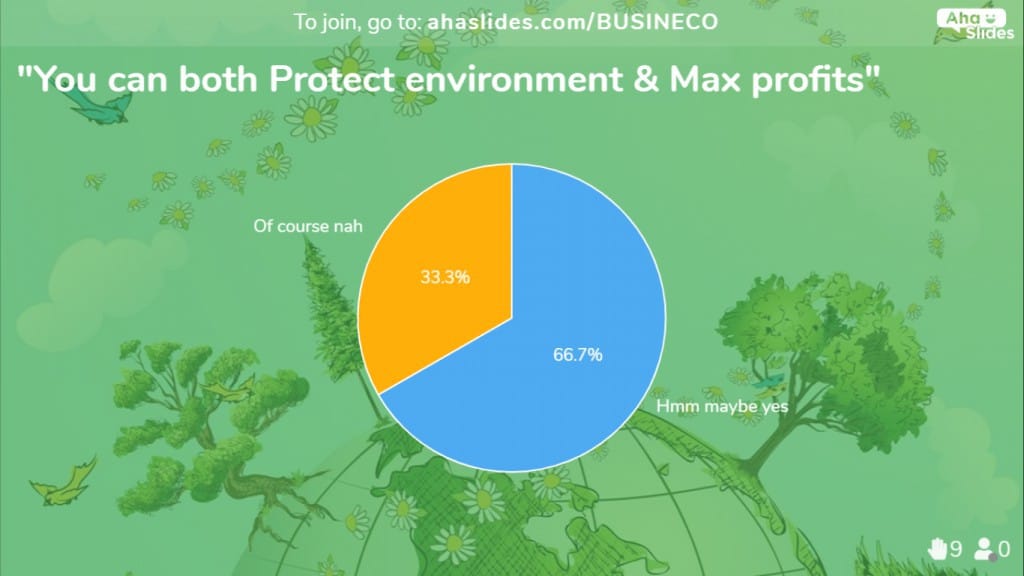
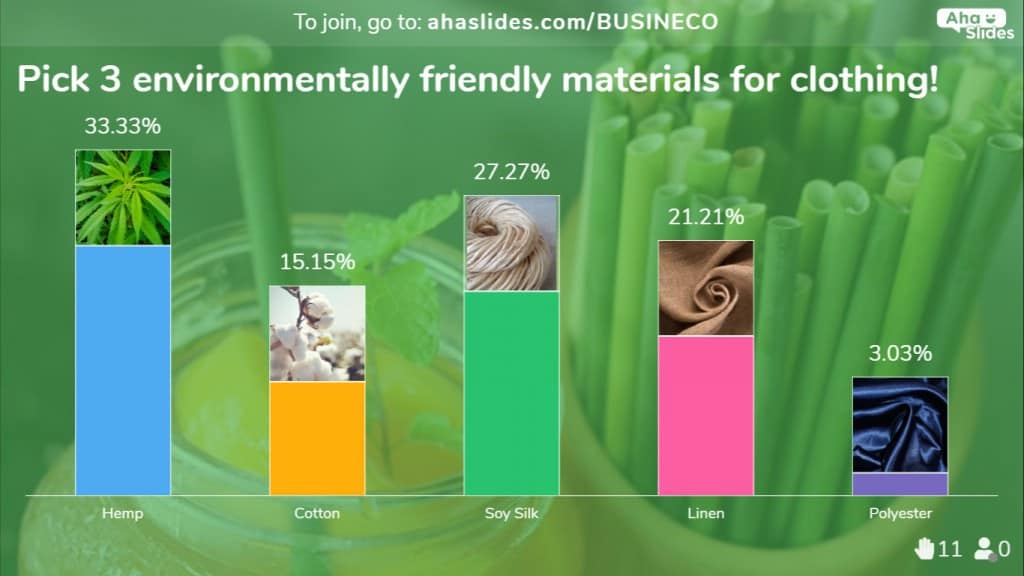
11. Two Truths and A Lie
This is a classic icebreaker game with a straightforward rule. You have to share three facts, only two of which are true, and the audience must guess which one is the lie. The statements can be about you or the audience; however, if attendees have never met before, you should give out prompts about yourself.
Collect as many sets of statements as possible, then create an online multiple-choice poll for each one. On D-Day, present them and let everyone vote on the lie. Tip: Remember to hide the correct answer till the end!
You can get ideas for this game here.
12. Flying challenges
Icebreakers mostly centre around you – the presenter – handing out questions and requests to the audience, so why not mix it up and have them take turns challenging each other? This game is a physical task that gets people moving. It’s a beautiful way to rock the whole room and get people interacting.
Give out paper and pens to the audience and ask them to think of challenges for the others before crumpling them into balls. Then, count down from three and throw them into the air! Ask people to grab the one nearest them and invite them to read the challenges.
Everyone loves winning, so you can’t imagine how challenging this can be! The audience will be even more motivated if you put up a prize for the most exciting questions!
13. Super competitive quiz games
Nothing can beat games at hyping people up. Knowing this, you should have your audience jump straight into a fun quiz at the beginning of your presentation. Wait and see how energised and hyped up they become!
The best thing: This is not limited only to entertaining or easy-going presentations, but also more “serious” formal and scientific ones. With several topic-focused questions, attendees can get a clearer insight into what ideas you are about to bring them while becoming more familiar with you.
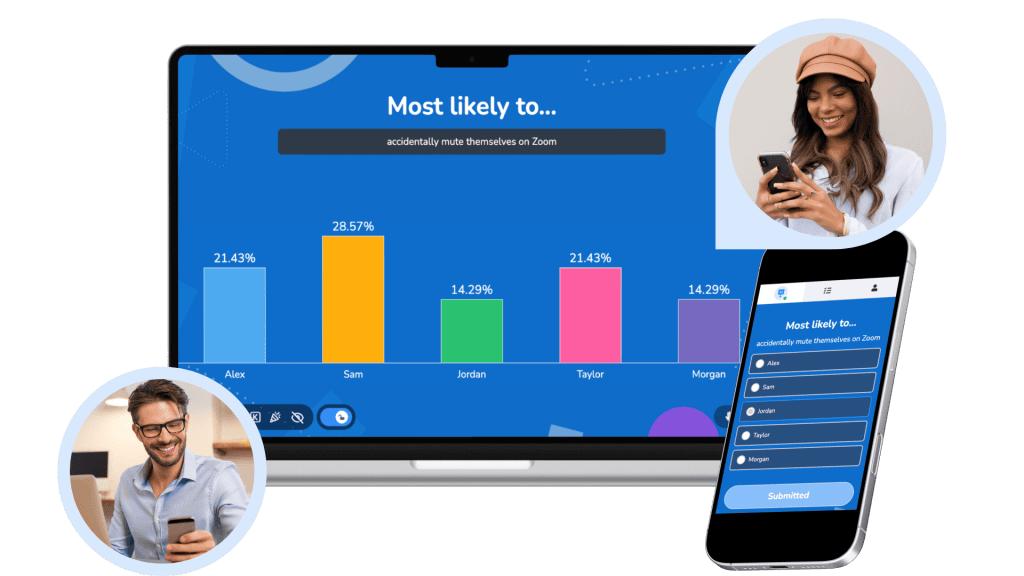
If you are successful, the preconception that a presentation must be painstakingly nerve-wracking disappears almost immediately. All that is left is pure excitement and a crowd eager for more information.
Need more interactive presentation ideas? AhaSlides got you covered!
